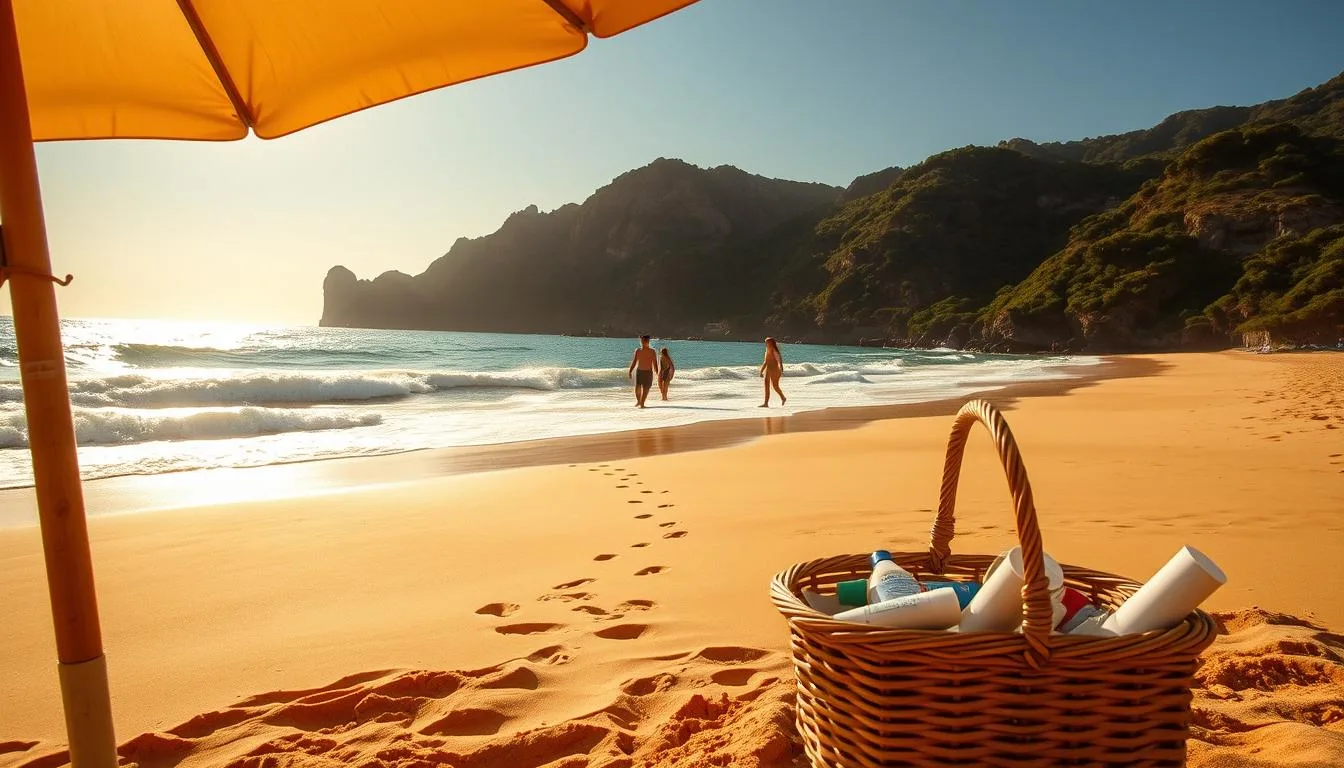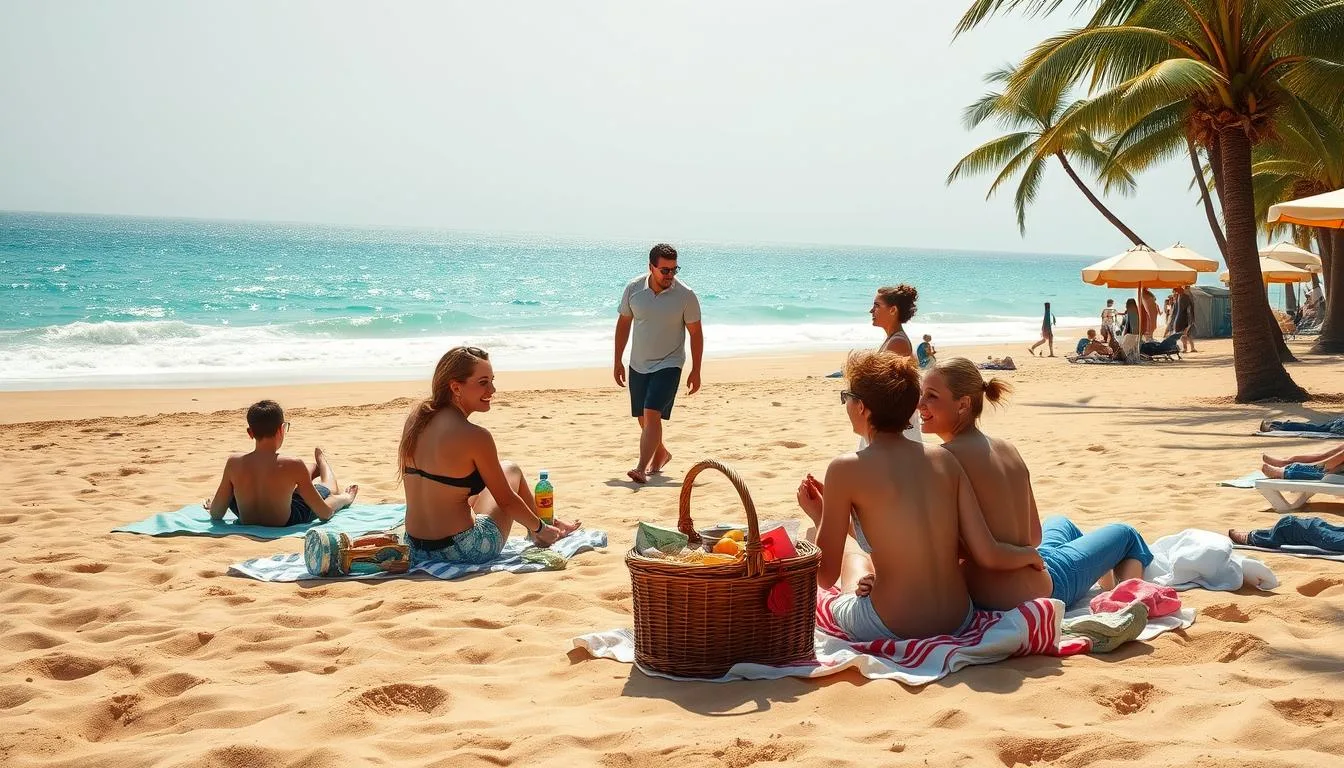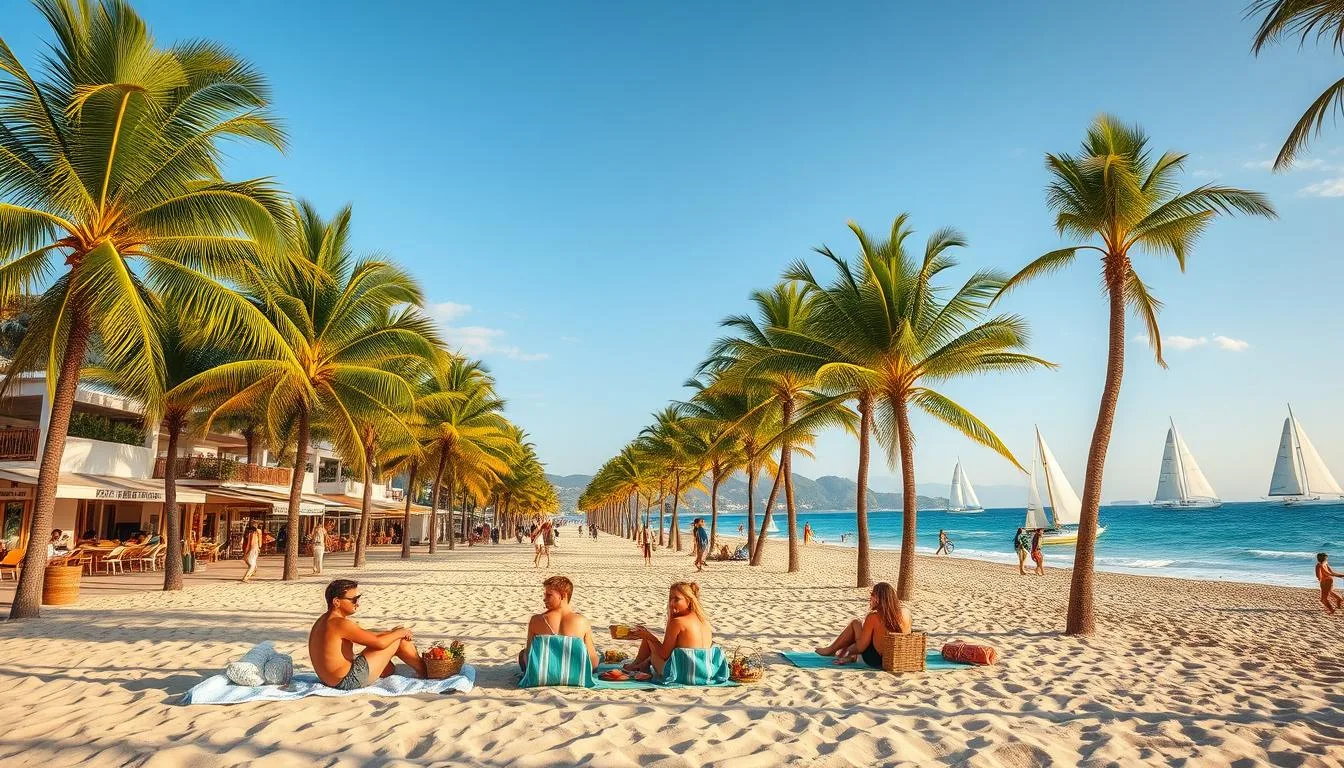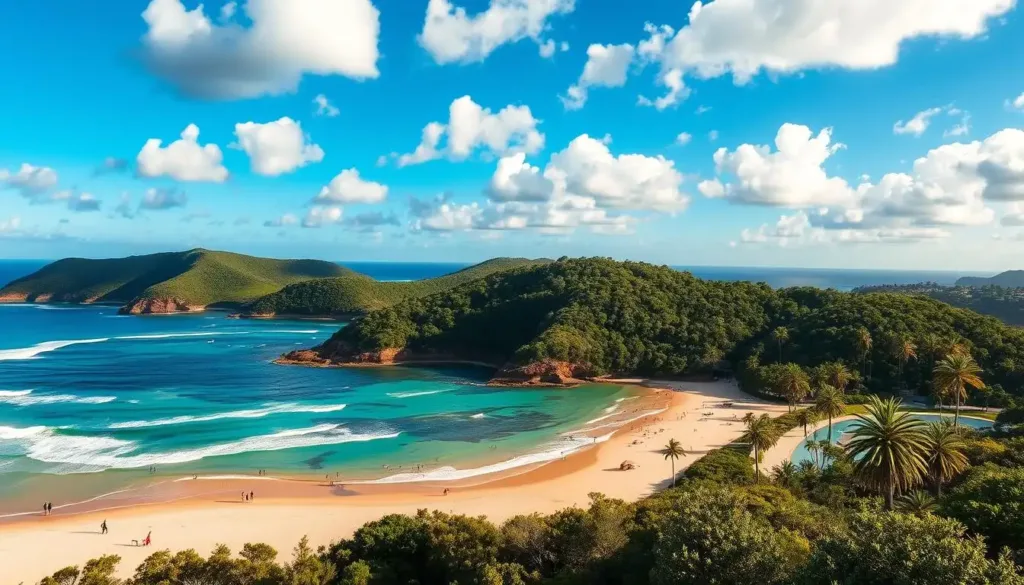
Planning a seaside trip this year? These 15 must-know beach travel tips for 2025 give U.S. travelers fast wins and smart planning moves. Expect practical advice on a modern beach packing list, updated beach safety 2025 guidance, and ways to save time and money while staying eco-friendly.
We draw on trusted sources like NOAA for tides and weather trends, CDC guidance for sun and water safety, and TSA and major airlines for booking and contactless services. The goal is simple: make your seaside vacation tips both actionable and realistic so you get more comfort and fewer surprises.
Read on for quick tips—what to pack, how to avoid crowds, useful apps, and family-focused advice—that blend safety, savings, and sustainability for 2025 beach travel.
Key Takeaways
- Check NOAA and local forecasts before you go to plan around tides and storms.
- Use a concise beach packing list to avoid overpacking and keep essentials handy.
- Follow CDC sun and water safety guidance to reduce risks during your trip.
- Book flexible options and learn airline contactless trends to simplify travel.
- Choose eco-friendly gear and reef-safe sunscreen to protect beaches for future visits.
Planning Your Beach Trip in 2025: What’s Changed
Planning a coastal getaway in 2025 means paying attention to a few shifts that affect timing, costs, and safety. Start with local rules and weather and finish with how you reserve services. A little prep smooths the whole trip.
Updated travel restrictions and local rules
Most pandemic-era mandates have eased across the United States, but city and county ordinances still shape access. Many towns control beach hours, parking permits, and dog rules. National Park Service sites have their own codes for federal coastal areas.
Check official city, county, and state parks pages before you go. Some municipalities limit beach capacity on busy weekends and holidays. Confirm permit needs for events, bonfires, or commercial activities in advance.
Weather trends and seasonal shifts to watch
NOAA reports show warmer average coastal temperatures and earlier peaks in some popular beach seasons. That shifts when crowds arrive and when water temps make swimming pleasant.
Storm-driven closures are more frequent in certain regions. Monitor hurricane season dates for the Atlantic (June 1–Nov 30) and follow El Niño/La Niña outlooks. Local tide and water-temperature updates help you pick the best days for swimming.
New booking habits and contactless services
Travelers favor flexibility and streamlined arrival. Hotels increasingly offer mobile check-in and keyless entry. Short-term rentals on Airbnb and VRBO add self-check-in options that cut in-person contact.
Airlines and airports have expanded mobile boarding passes and curbside luggage services. Look for flexible cancellation policies and use fare-alert tools like Google Flights or Hopper to track good deals.
Reserve extras ahead of time when possible. Parking spaces, beach chair rentals, and water-sport slots often sell out on peak dates. Prior booking reduces stress and supports smooth on-site operations.
| Topic | 2025 Change | What to Do |
|---|---|---|
| Local access rules | More varied by municipality; capacity limits at peak times | Visit city/county websites; secure permits and check hours |
| Federal coastal sites | Standardized National Park Service rules; some seasonal closures | Consult NPS pages for regulations and alerts |
| Seasonal weather trends | Warmer averages; earlier peak seasons; more storm closures | Follow NOAA updates and local tide/water temps |
| Hurricane and climate outlooks | Active Atlantic season window remains June 1–Nov 30 | Plan flexible dates; buy travel insurance when needed |
| Booking and arrivals | Rise in mobile and self-service check-in options | Choose properties with contactless booking and clear policies |
| On-site reservations | High demand for chairs, rentals, and parking | Reserve equipment and parking in advance |
Packing Essentials for a Comfortable Beach Vacation
A smart beach packing list keeps your day relaxed and safe. Start with basics and add items that protect you from sun and salt. Pack gear that dries fast, shields your skin, and keeps devices dry and charged.
Sun protection: sunscreen, hats, and UPF clothing
Choose a broad-spectrum sunscreen SPF 30 or higher for regular days, SPF 50 for long exposure. Reapply every two hours and after swimming. Pick reef-safe formulas with zinc oxide or avobenzone to protect oceans and skin.
Bring a wide-brimmed hat and ANSI- or ISO-polarized sunglasses to cut glare. Don’t forget an SPF lip balm and a small first-aid item with sunscreen notes from FDA guidance.
Invest in UPF clothing from brands like Columbia, Patagonia, or items from REI. Lightweight UPF clothing reduces burn risk and pairs well with sun protection tips for long beach afternoons.
Beach gear: towels, chairs, umbrellas, and portable shade
Microfiber quick-dry towels and sand-resistant beach blankets save space and clean up fast. Pack a lightweight folding chair if you want back support on uneven sand.
Select umbrellas or pop-up shelters rated for local wind conditions. Use sand anchors such as screw anchors or sandbags to secure shade. A sun shelter with secure anchors adds comfort for families and long reads.
For active days, add snorkel gear, reef boots, and a dry bag to keep valuables safe and dry. These items make your beach packing list more versatile and ready for water play.
Electronics and power: waterproof cases and portable chargers
Protect phones with a waterproof phone case or an OtterBox or LifeProof-style case for rugged use. Waterproof pouches let you use the screen while keeping salt and sand out.
Carry a portable charger rated 10,000–20,000 mAh to power phones, cameras, and speakers through a long day. A solar charger adds backup for multiday trips. Pack charging cables and a compact power strip for shared accommodations.
Choose waterproof Bluetooth speakers with an IP67 rating for beach tunes. These choices complete a practical packing list that balances fun and preparedness.
Beach Travel Tips for Families and Kids
Family beach days can be joyful with the right preparation. Keep plans simple, set clear rules, and pack essentials to reduce stress. Use these family beach tips to balance fun and safety for parents and children.
Safety first: floatation devices and water rules
Choose U.S. Coast Guard–approved life jackets for non-swimmers and young kids. For toddlers, consider wearable flotation suits that allow safe movement while keeping them buoyant.
Teach children to swim within designated swim zones and near lifeguard towers. Learn flag meanings at the beach and show kids how to spot the nearest lifeguard station.
Set a buddy system and name a responsible watcher when anyone is in the water. Keep small children within arm’s reach and avoid strong currents or unknown drop-offs.
Keeping kids entertained: beach games and educational finds
Pack sandcastle tools, kites, and small beach-safe toys for easy play. A lightweight inflatable can add supervised fun without taking much space.
Plan a shell scavenger hunt and use field guides like Monterey Bay Aquarium or Audubon to teach kids about local marine life. Tide-pool exploration makes a great hands-on lesson in nature.
Rotate activities to prevent boredom. Short, varied games keep energy up and reduce crankiness that can spoil a day at the shore.
Snack and hydration planning for long beach days
Bring insulated coolers and reusable water bottles from Nalgene or Hydro Flask to keep drinks chilled. Add electrolyte powder or sports drinks for very hot days to maintain balance.
Pack a mix of non-perishable items and chilled fruit: trail mix, granola bars, and sliced melon travel well. Offer frequent small portions to avoid energy crashes and limit sun exposure during big meals.
Practice food safety by keeping perishables cold and discarding items left out too long. Thoughtful beach snacks help kids stay happy and hydrated all day.
Money-Saving Strategies for Beach Getaways
Smart planning keeps your trip fun and light on the wallet. Use timing, food choices, and local discounts to save money beach vacation costs without cutting experiences. Small adjustments add up fast.

When to book flights and accommodations for the best deals
Book domestic U.S. flights one to three months ahead for summer peaks. For hot spots like Maui or Miami, aim for three to six months before high season to lock lower fares. Fly midweek to find cheaper seats and quieter airports.
Track prices with Google Flights, Skyscanner, or Hopper and set alerts. For lodging, compare direct hotel rates versus OTAs like Expedia. Vacation rentals with a kitchen can cut meal bills for families. Pick flexible cancellation when possible.
Using local markets and picnics to cut dining costs
Hit farmers markets, seafood counters, and grocery stores to build beach picnics. Fresh shrimp, oysters from reputable sellers, salads, and pre-cut fruit make easy, tasty meals.
Packing breakfasts and a few DIY dinners lowers restaurant bills a lot. Budget chains like Aldi and Trader Joe’s often appear in coastal towns. Visit local fishermen’s markets for the freshest, most affordable seafood.
Discounts for parking, passes, and off-peak activities
Municipal parking apps such as ParkMobile and Passport can help you find beach parking discounts and daily caps. Buy state park passes if you plan multiple visits; a California State Parks annual pass pays off fast for frequent travelers.
Book tours and rentals during shoulder seasons and off-peak beach trips to score lower rates. Check AAA, AARP, student, and military discounts for attractions and gear rentals. Small moves like these support cheap beach travel without cutting fun.
Safety and Health at the Beach
Staying safe at the shore means preparing for common hazards and knowing simple fixes that keep a day at the beach fun. Read the flags, scan the water, protect your skin, and keep fluids close. Small actions prevent big problems.
Recognizing rip currents and reading lifeguard flags
Learn rip current signs before you enter the water. Look for a choppy channel, water that appears darker or murkier than surrounding areas, or foam and debris moving seaward. Those are indicators of a strong flow away from shore.
If caught in a rip, do not try to swim directly back to shore against the current. Float calmly or swim parallel to the beach until you escape the flow, then head inshore at an angle. Follow lifeguard instructions and ask about local conditions when you arrive.
Beach flag systems vary by location. A green flag usually means calm conditions, yellow signals caution and changing hazards, and red warns of dangerous surf or strong currents. Some beaches use double red flags to indicate swimming is prohibited. When in doubt, speak to the lifeguard on duty.
Sun exposure management and treating minor injuries
Prevent sunburn by applying broad-spectrum sunscreen with at least SPF 30, wearing UPF clothing, and seeking shade between 10 a.m. and 4 p.m. Reapply sunscreen after swimming and heavy sweating.
For cuts and scrapes, rinse with clean water, apply an antiseptic, and cover with a sterile bandage. Know the nearest urgent care or pharmacy in case stitches or professional care are needed.
Treating jellyfish stings depends on species. Common advice for many stings is to rinse with vinegar and remove tentacles with a gloved hand or a flat object. Do not rinse with freshwater, as it can increase pain. Check guidance from local park or health departments for species-specific care.
Staying hydrated and avoiding heat-related illness
Drink water regularly and do not wait until you feel thirsty. Include electrolyte drinks during long exposure in hot weather. Limit alcohol during the hottest hours because it speeds dehydration.
Know heat exhaustion and heat stroke signs. Heat exhaustion may include heavy sweating, weakness, dizziness, and nausea. Heat stroke shows confusion, loss of consciousness, very high body temperature, or hot dry skin. Move the person to shade, cool the skin with wet cloths, hydrate if conscious, and call 911 for severe symptoms.
Keeping these basics in mind improves beach safety for everyone. A quick chat with the lifeguard and a small first-aid kit go a long way toward a worry-free day by the water.
Beach Travel Tips
Picking the right shoreline sets the tone for any trip. Think about whether you want calm solitude or lively beach action. Match the beach to your plans and check official tourism pages and guides for facility info before you go.
Choosing the right beach for your travel style
Quiet natural spots like Cape Cod National Seashore or Assateague Island suit birdwatching, long walks, and solitude. Active resort shores such as Waikiki or Myrtle Beach work best for surfing, nightlife, and rentals. Compare amenities: restrooms, showers, rental shops, and accessibility.
Think about activities. Families may prefer lifeguarded beaches with shallow water. Snorkelers need calm reefs and clear water. Use state tourism sites and guidebooks to help choose best beach for your needs.
Timing your visit to avoid crowds and get prime conditions
Plan early mornings or late afternoons to avoid crowded beaches and enjoy lower winds and calmer seas. Check local tide charts to pick low tide for tidepooling or high tide for safer swimming.
Travel during shoulder seasons like late spring or early fall to get milder weather and fewer visitors while keeping services open. Arrive before peak hours for parking and a better spot on the sand.
Local etiquette and environmental responsibility
Respect shoreline rules: no glass, pack out trash, and follow posted signs for nesting sites and protected areas. Observe leash laws and local smoking bans to keep beaches safe for neighbors and wildlife.
Practice leave-no-trace habits. Stay on marked dune paths and avoid disturbing plants and nests. Small actions add up and support responsible beach travel for future visitors.
| Decision Point | Quiet Beach Example | Active Beach Example | Tip to Avoid Crowded Beaches |
|---|---|---|---|
| Best for | Solitude, birdwatching, nature walks | Surfing, dining, rentals | Visit at dawn or late afternoon |
| Facilities | Basic restrooms, limited rentals | Showers, shops, lifeguards | Check state tourism sites before travel |
| Wildlife concerns | High — nesting sites common | Lower — more developed shorelines | Follow beach etiquette and posted rules |
| Ideal season | Late spring, early fall | Summer peak season | Choose shoulder seasons for fewer crowds |
| Accessibility | May be limited, boardwalks vary | Often ADA-friendly and transit-accessible | Research parking and transit options ahead |
Smart Tech and Apps to Improve Your Beach Experience
A small set of tools can turn a good beach day into a great one. Use reliable apps for planning, navigation, and photography to stay safe, save time, and capture memories. Pick a few favorites so your phone stays organized and useful while you relax.
Weather and tide apps for safer planning
Check a trusted beach weather forecast before you leave. NOAA Weather, Windy, and AccuWeather give real-time updates and storm alerts. For water activities, consult a tide app or NOAA tide charts to track high and low tides, swell, and offshore wind. FEMA and the National Weather Service apps add emergency notices that matter for coastal trips.
Navigation and parking apps for busy beach towns
Gridlock can ruin a day. Use Google Maps or Waze for traffic and alternate routes. For metered parking, ParkMobile and Passport simplify payments. Many towns offer municipal parking apps for reservations. If you prefer two wheels, Lime and Bird provide scooter and bike rentals in many coastal areas.
Photography tips and apps for capturing beach memories
Shoot during golden hour for soft light and dramatic color. Turn on HDR for balanced exposure when the sun is bright. Use a floating wrist strap with action cameras to avoid losing gear in the surf. GoPro and DJI Action cameras handle water shots well.
For quick edits, try Adobe Lightroom Mobile, Snapseed, or VSCO. These best photo apps beach users rely on correct color, reduce glare, and crop for stronger compositions. Keep presets ready to speed up edits and maintain a consistent look across your photos.
Sustainable Beach Travel: Eco-Friendly Choices
Planning a low-impact beach day keeps shorelines healthy and makes travel more rewarding. Simple habits like packing a reusable bottle, choosing reef-safe sunscreen, and joining a local beach clean-up add up. Small changes help protect wildlife and support communities that depend on clean oceans.

Reducing single-use plastics and choosing reef-safe sunscreen
Bring a stainless steel water bottle and a set of silicone food bags to cut waste. Swap disposable utensils for a lightweight kit you can rinse and reuse. Pick reef-safe sunscreen with zinc oxide or a non-nano mineral formula. Check the Environmental Working Group guides and follow local rules in Hawaii and Florida that limit oxybenzone and similar chemicals.
Responsible wildlife viewing and beach clean-up tips
Watch sea turtles, birds, and seals from a distance. Never feed wildlife or disturb nests. Carry a small trash bag and gloves to collect debris. Use tweezers for micro-plastics and stow fishing line and cigarette butts in a sealed container for proper disposal. Join organized events hosted by groups such as the Surfrider Foundation when possible.
Supporting local conservation efforts and businesses
Donate to or volunteer with local organizations like The Nature Conservancy coastal programs and state park foundations. Eat at family-run restaurants and buy fresh catch from local fishermen to keep tourism dollars in the community. Buying locally made crafts helps fund conservation while giving you an authentic connection to the place.
Beach Dining and Local Eats: What to Know
Eating well at the shore blends safety, flavor, and a sense of place. Use simple beach dining tips to keep meals fresh and fun. Think ahead about storage, vendor selection, and dishes that travel without trouble.
Best practices for seafood safety and freshness
Buy seafood from licensed vendors like certified fish markets or family-run docks. Look for clear eyes on whole fish, firm flesh, and no strong fishy odor. For shellfish, check local advisories for red tide or closures posted by state health departments or NOAA.
Follow FDA guidance on temperatures: keep perishables at 40°F or below and cook seafood to recommended internal temps. Chill cooked shrimp and clams promptly. When in doubt, toss anything left too long in the sun to protect against foodborne illness.
Packing picnic-friendly meals and keeping food safe
Choose items that travel well: cold pasta salads, wraps, cooked shrimp chilled, hard cheeses, apples, and grapes. Pack insulated coolers with ice packs or block ice to keep foods cold for hours. Store perishable items on the bottom and open coolers minimally to hold temperature.
Bring hand sanitizer and wet wipes for clean hands before eating. Label containers with the time you packed them. Discard food that sits above 40°F for more than two hours in warm weather. These beach picnic ideas help reduce waste and risk.
Finding authentic local cuisine and supporting small vendors
Research regional specialties before you go. In New England, seek clam shacks known for fresh clams. In the Gulf, try shrimp po’boys from family-run spots. On the Pacific Coast, look for fresh salmon preparations at local eateries and fish markets.
Use recent reviews to confirm hours and quality. Visit farmers’ markets and community fish markets for seasonal catches and ready-to-eat options. Choosing small vendors supports the local economy and often delivers the best local beach food experiences.
| Tip Category | What to Look For | Practical Action |
|---|---|---|
| Vendor Selection | Licensed sellers, clear reviews, local health notices | Buy at certified fish markets, check state health or NOAA alerts |
| Freshness Signs | Clear eyes, firm flesh, mild scent for fish and shellfish | Inspect before purchase; avoid strong odors or soft flesh |
| Storage & Safety | Keep items ≤40°F, use insulated coolers and ice packs | Pack block ice, arrange perishables on bottom, label times |
| Picnic Menu Ideas | Travel-friendly foods that chill well | Cold pasta salad, wraps, cooked chilled shrimp, hard cheeses, sturdy fruits |
| Supporting Locals | Family-run eateries, markets, food trucks | Check recent reviews, confirm hours, buy seasonal specialties |
Packing Light: Minimalist Tips for Beach Lovers
Travelers who want ease and freedom should aim for minimalist beach packing. A focused kit shortens airport time and keeps hotel rooms tidy. Start with a clear plan for outfits, gear, and important papers so you can pack with purpose for a pack light beach trip.
Versatile clothing choices and quick-dry fabrics
Choose mix-and-match pieces that work for day and night. Look for Uniqlo AIRism tops, Patagonia Capilene baselayers, or ExOfficio shirts that wick sweat and dry fast. Swimwear that doubles as a top and convertible pants that zip off into shorts save space.
Bring one lightweight cover-up for sun protection and one casual outfit for dinner. Prioritize quick-dry travel clothes so you can wash items in the sink and wear them the next day.
How to compress gear and choose multi-use items
Pack cubes and a compression sack for towels and bulky layers. Swap a heavy beach towel for a microfiber travel towel that rolls small. Inflatable pillows and loungers take little room and add comfort without bulk.
Pick multi-use items: a sarong that becomes a blanket or shade, reef shoes that double as water and walking shoes, and a small dry bag that holds wet swimsuits or valuables.
Medication, documents, and must-have small items
Keep prescriptions in original containers and bring printed copies of scripts. Add basic OTC meds: pain relievers, antihistamines, and a compact first-aid kit. Store travel documents beach essentials—ID, reservation printouts, and insurance info—in a waterproof pouch.
Back up digital copies of passports and itineraries to secure cloud storage. Bring a credit card with chip and contactless options for faster transactions while you pack light for a beach trip.
Conclusion
This beach trip summary pulls together the most important points for planning your beach trip 2025. Keep updated local rules and weather trends in mind, pack reliable sun protection and safety gear, and use smart tech like tide and weather alerts to stay informed. Prioritize hydration, rip-current awareness, and basic first-aid to keep every day on the sand safe and fun.
For final beach travel tips, think ahead about money and convenience: book flights and rentals early, use local markets for meals, and reserve any permits or parking passes before you go. Embrace minimalist packing with multi-use items and quick-dry fabrics to reduce luggage stress and make room for beach gear like a compact umbrella or life jackets.
As action steps, create a concise pre-trip checklist with documents, sunscreen, flotation devices, phone power, and a cooler. Subscribe to NOAA and local tide or weather alerts for your destination and confirm rules on state park or county websites. U.S. coastal rules vary widely, so checking official local resources ensures a safe, eco-friendly, and enjoyable seaside escape in 2025.



